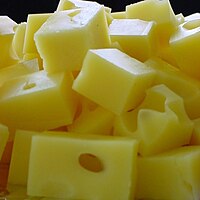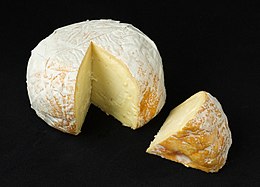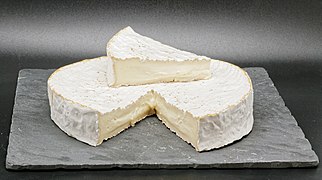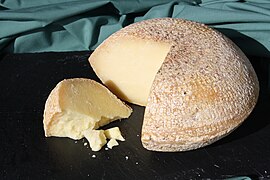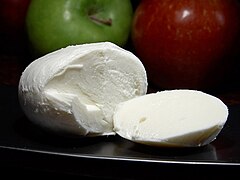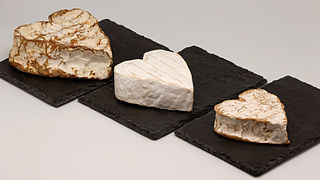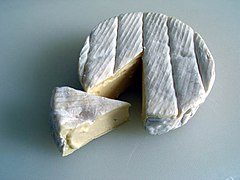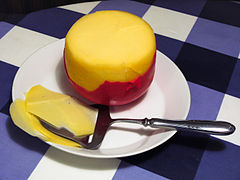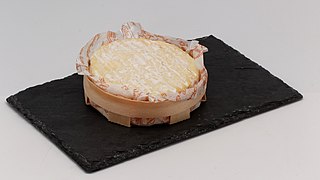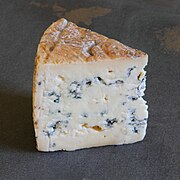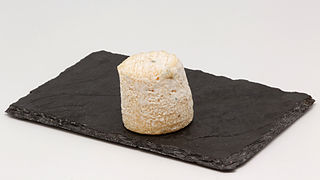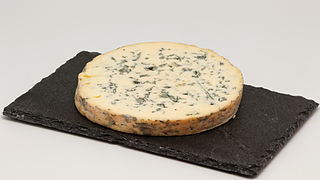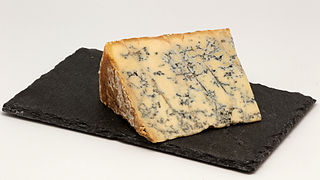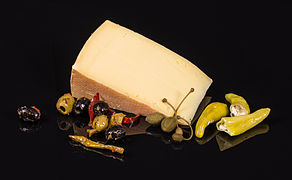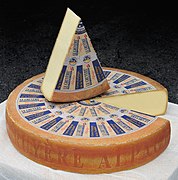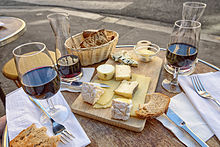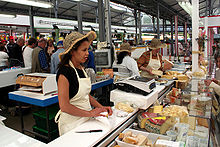
أضرار الجبنة البيضاء
الجبنة تعد الأجبان مصدرًا غنيًّا بالكالسيوم والبروتين، وتحتوي على نسبة مرتفعة من الدّهون المشبعة والصّوديوم، وتعد الأجبان مرافقًا أساسيًّا للعديد من الأطعمة الشعبيّة مثل: البرغر والسندويشات والبيتزا والأطباق المكسيكيّة والسلطات والمعجنات، كما أنّها تعد وجبةً خفيفةً يمكن تناولها منفردةً، ويوجد العديد من الأصناف المختلفة من الاجبان التي تختلف في نكهاتها وتركيبتها وطريقة صنعها مثل: الجبن كامل الدّسم والجبن قليل الدّسم والأجبان الطّازجة والأجبان القديمة والأجبان التي لا تحتوي على الألبان كجبن الصّويا، وفي هذا المقال سيتم الحديث تحديدًا عن الجبنة البيضاء وعن أضرار الجبنة البيضاء ومخاطر تناولها.[١] أضرار الجبنة البيضاء تعد الأجبان مادّة غذائيّة مفيدةّ جدًّا للجسم لكنّها قد تحمل بعض الأضرار والمخاطر الصحيّة النّاتجة عن زيادة استهلاكها في النّظام الغذائي نظرًا لمحتواها الغني بالصوديوم والدهون المشبعة الذي قد يسبب بعض المشكلات الصحيّة، وفي ما يأتي توضيح لأضرار الجبنة البيضاء النّاتجة عن تناول بعضًا من أنواعها المختلفة:[١] جبن الريكوتا Ricotta Cheese هو عبارة عن جبن يتم استخدامه في حشوات اللازانيا والأصداف المحشوّة والبيتزا والحلويات الإيطاليّة عادةً، يتم صُنعه من مصل اللبن والحليب كامل الدّسم، يحتوي على الفيتامينات والمعادن المهمّة لكنه مرتفع جدِّا بالسّعرات الحراريّة، إذ يحتوي كوب واحد منه على 428 سعرةً حراريّةً و32 غرام دهون معظمها من الدّهون المشبعة التي تسبب بعض المشكلات الصحيّة مثل: زيادة نسبة الكولسترول في الدّم مما يساهم في رفع خطر الإصابة بأمراض القلب والأوعية الدّمويّة،[٢] كما تحتوي الحصّة الغذائيّة الواحدة على 126 مليغرام كولسترول ووفقًا للإرشادات الغذائيّة الصحية والوقاية من الأمراض فإنّ الجسم يقوم بإنتاج الكولسترول ولا حاجة للحصول عليه عن طريق الطّعام، وليس بالضّرورة أن يؤدّي تناول الكولسترول إلى رفع الكولسترول في الجسم لكن في حال وجود تاريخ للشِّخص بارتفاع الكولسترول ينصح بتوخي الحذر واستشارة الطّبيب حول إمكانيّة تناول الاطعمة الغنيّة بالدّهون لتجنّب المخاطر والأضرار المحتملة.[٢] جبن الفيتا Feta Cheese هو جبن يوناني الاصل مملّح على شكل مكعبات مصنوعة من حليب الغنم أو خليط من حليب الماعز والأغنام، تمتاز بنكهتها الفريدة والمنعشة والحادّة، وتتمتّع بملمسها وطبيعتها الكريميّة في الفم، يعد جبن الفيتا مصدرًا غنيًّا بالمواد الغذائيّة لكن نظرًا لطريقة صنعها ونوع الحليب المستخدم في صُنعها قد تسبب بعض الأضرار الصحيّة وتشمل:[٣] يحتوي على كميات كبيرة من الصوديوم حوالي 312 مليغرام للحصة التي تعادل 28 غرام. يحتوي على اللاكتوز الذي يؤثّر على الأشخاص الذين يعانون من الحساسيّة أو عدم تحمّل اللاكتوز. يحتوي على بكتيريا تسمى Listeria monocytogenes في حال تم صنعه من الحليب غير المبستر، لذلك ينصح بتجنب الحوامل من تناوله لارتفاع نسبة الرطوبة والجراثيم الموجودة. جبن الموزاريلا Mozzarella Cheese يعود منشأه إلى نابولي في إيطاليا، ويتم انتاجه من لبن الجاموس المائي، والآن يتم صنعه اعتمادًا على حليب البقر الطّازج، يتم استخدامها في تحضير البيتزا، وتمتاز بانخفاض نسبة الرّطوبة فيها واحتوائها على العناصر الغذائيّة الصحيّة والمهمّة مثل: البروتينات والمعادن الأساسيّة والفيتامينات القابلة للذوبان في الماء والدّهون، تعد آمنة جدًّا ومفيدةً ويعد الضرر الوحيد المحتمل هو؛ عدم فقدان الوزن لمن يرغب بذلك نتيجةً لارتفاع نسبة الدّهون فيها في حال تم صٌنعها من الحليب كامل الدّسم، لذلك ينصح بقرأة ملصق المحتويات الموجود على الجبنة قبل تناولها واختيار الاصناف المصنوعة من الحليب خالي الدّسم.[٤]

طريقة عمل الجبنة القريش في المنزل.. وأهم فوائدها
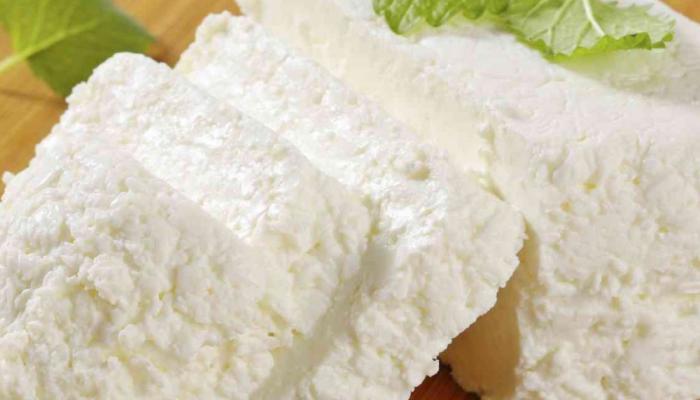
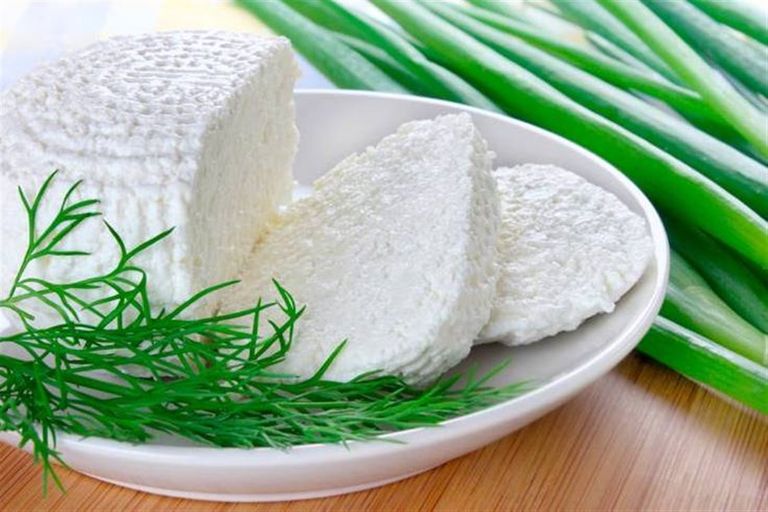
مقادير الجبنة القريش:
- 4 لترات من اللبن البقري المبستر.
- 4 ملاعق كبيرة من الخل الأبيض.
- القليل من الملح.
طريقة تحضير الجبنة القريش في المنزل:
- نضع الحليب في وعاء على النار على درجة حرارة متوسطة ويترك حتى الغليان.
- يضاف الخل إلى اللبن مع التقليب.
- يرفع اللبن من على النار ويضاف إليه القليل من الملح.
- نغطي الوعاء بقطعة من القماش وتترك لمدة لا تقل عن الساعتين حتى يتم فصل طبقة سميكة عن الطبقة السائلة من اللبن.
- نحضر مصفاة ويفرش بها قطعة من الشاش وتوضع المصفاة فوق وعاء.
- يتم أخذ الطبقة السميكة باستخدام مغرفة وتوضع في المصفاة.
- تغطى بقطعة أخرى من الشاش، ويوضع فوقها شيء له وزن ثقيل وتترك حتى تصفى من الماء نهائيا.
- نحضر كيسا من النايلون ويوضع به الجبنة، ويلف جيدا مع الضغط عليه.
- توضع الجبنة في الثلاجة حتى وقت الاستخدام.. وبالهناء والشفاء
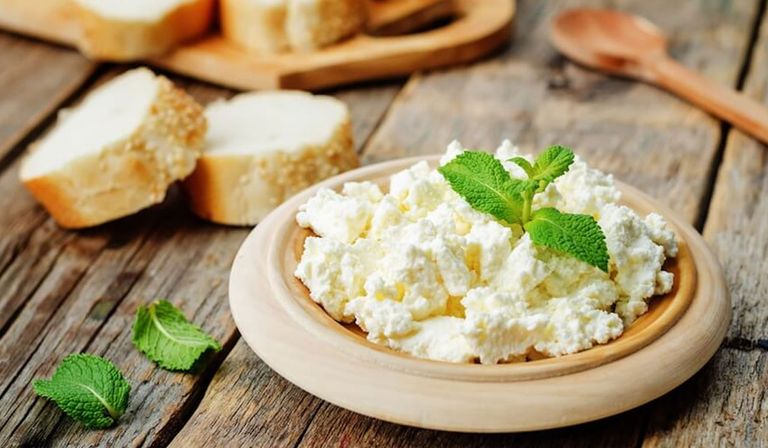
فوائد الجبنة القريش:
- تعتبر الجبنة القريش مصدرا جيد للكالسيوم، والذي يلعب دورا رئيسيا في حماية صحة الأسنان والعظام، كما أنه يقي من مرض هشاشة العظام.
- تساعد الجبنة القريش على تنظيم معدل ضغط الدم، وهذا لمحتواها المتوازن من الأملاح.
- التقليل من متلازمة التمثيل الغذائي، والتي تشمل مستويات السكر المرتفعة، ولهذا فإن الحرص على تناول الجبنة القريش من الأشياء المهمة لمرضى السكري، ولكن دون إفراط بالطبع وعدم تجاوز الكمية التي يحددها الطبيب,
- التقليل من الوزن الزائد، حيث إن الجبنة القريش تحتوي على نسبة قليلة من الدهون والسعرات الحرارية.
- تحتوي الجبنة القريش على البروبيوتك الطبيعي، والذي له الكثير من الفوائد المهمة لصحة المعدة والأمعاء.
- تعتبر من أهم أنواع الجبنة للأطفال، وتساعد على نموهم بالشكل السليم.
- تساعد الجبنة القريش على الحد من أعراض القلق والتوتر التي يشعر بها الإنسان.
- الجبنة القريش مفيدة للمرأة الحامل، حيث تمدها بحمض الفوليك، والذي يعتبر من الأحماض المهمة للجنين وحمايته من التشوهات الخلقية.
- تحتوي الجبنة القريش على عنصر البوتاسيوم، والذي يساعد على تنشيط الأعصاب والدماغ، بالإضافة إلى الحماية من تشنجات العضلات.

طريقة عمل الجبنة البيضاء
جبن
| جبن | |
|---|---|
|
صحن من المقبلات والأجبان
|
|
|
|
|
| القيمة الغذائية لكل (100 غرام) | |
| الدهون | |
| الفيتامينات | |
| معادن وأملاح | |
| معلومات أخرى | |
| النسب المئوية هي نسب مقدرة بالتقريب باستخدام التوصيات الأمريكية لنظام الغذاء للفرد البالغ. |
|
الجُبنَةُ غذاء معروف مصنوع من الحليب.[1][2][3] يصنع الجبن في بعض الدول من حليب الماعز أو حليب الغنم أو حليب البقر أو من أي نوع من أنواع حليب الحيوانات الأليفة اللبونة. قد يكون الحليب مبستراً أو غير مبستر مقشوط أو بكامل دسمه. قد يكون حامضاً أو حلواً.
أصل الكلمة
الْجُبْنُ: ما جُمِّدَ من الحليبِ وصُنِع بطريقةٍ خاصة.
لمحة تاريخية
- مقال تفصيلي: تاريخ الجبن
الجبن طعام قديم، يقال إن جذوره تسبق التاريخ المسجل، تعود إلى أسلوب نقل الألبان في المثانة المأخوذة من معدة الحيوان المجتر، فهي المصدر الأصلي للمنفحة. ولا يوجد دليل حاسم يدل على موطن نشأة صناعة الجبن سواء كان في أوروبا أو في آسيا الوسطى أو في الشرق الأوسط أو في الصحراء الكبرى. ولقد انتشرت صناعة الجبن في أوروبا مع بدايات الميثيولوجيا الإغريقية ووفقًا لبلينيوس الأكبر، أصبحت صناعة الجبن مشروعًا متطورًا عند نشأة روما القديمة، عندما كانت الأجبان الأجنبية القيمة تنقل إلى روما لإرضاء أذواق الصفوة. إن ثقافة الشعوب مختلفة ففي كل بلد أو حتى قرية منبع من كنوز الطبيعة التي تأسر القلوب. كما أننا نشاهد مؤخرا عالم لم نشهد له مثيل اختلافات بل أصناف لم نشهدها قبل في الجبن مزج نكهات بل إضافات لم نكن نتوقعها. فمثلا إيطاليا، فرنسا، بلجيكا، بولندا، هولندا، إنجلترا، وغيرها من الغرب تمتع بإذهال المشاهدين بما تصنعه بل بما تبتكره لتثبت وجودها في عالم الجبن الذي لا نهاية له. الكل يعلم بالمقولة الشهيرة التي وردت في عام 1546، حيث ذكر كتاب أمثال جون هيوود أن “القمر مصنوع من جبن أخضر.” (ولا تشير كلمة الأخضر هنا إلى اللون، كما قد يتبادر إلى الذهن، بل تشير إلى دوام التجدد وعدم التقدم في العمر.) ولقد ترددت أشكال كثيرة لهذا الشعور على مدار فترة طويلة واستغلت وكالة ناسا هذه الخرافة في خدعة يوم كذبة إبريل عام 2006. وهناك قصة تروي اكتشاف الجبن قبل 1500 سنة هجري. حيث هناك أبحاث تقول بأن قطعة الدهون التي عثر عليها في معدة رجل الثلج، المومياء التي يبلغ عمرها خمسة آلاف عام، والتي تم اكتشافها في مقاطعة جنوب تيرول، من الممكن أن تكون قطعة جبن عتيقة بما يعني أنها قد تكون أقدم قطعة جبن في تاريخ البشرية، وسميت مومياء رجل الثلج باسم أوتزي على اسم جبال الألب في أوتزتال حيث عثر عليها في جبل جليدي في مرحلة الذوبان في عام 1991م، يذكر أنه عاش في الفترة ما بين عامي 3350 و 3100 قبل الميلاد، وتم العثور على القطعة الدهنية في معدة رجل الثلج – جنبا إلى جنب مع بقايا وجبة أخيرة تناولها قبل الوفاة. كما يذكر ان العلماء قاموا بتسجيل أقدم قطعة جبن إلى حوالي عام 1615 قبل الميلاد أيضًا، عقب اكتشاف جبن الكفير بين جثث محنطة في صحراء تكلماكان في الصين، أما إذا كان رجل الثلج كان قد أكل الجبن، فإن هذا من شأنه أن يعود بتاريخ الجبن إلى الوراء 1500 سنة أخرى.
طريقة عمل الجبن
يكون الجبن بفعل أنزيم الرنين المسمى بالمنفحة. ويمكن استخلاص حوالي 16 كغم من الجبن من كل 100 كغم من الحليب. ويخلط مع الجبن بعض الأعشاب المنسمة والثوم البري ويحفظ في جلود الحيوانات ثم تدفن لفترة معينة لاستكمال تخمرها يسمى هذا النوع من الجبن جبن البشاري أو جبن بيزة تشتهر فيه قرى شمال العراق وشرق سوريا.
الأنواع

جبن غودا في سوق للأجبان
هناك أنواع كثيرة من الأجبان ولكل بلد نوع من الجبن تختص بصنعه وتتميز به. ومن أشهر الأجبان في العالم الأجبان الفرنسية حيث هناك حوالي 370 نوع من الأجبان المختلفة، ويقال بأن شارل ديغول قال مازحاً كيف يمكنه حكم بلد فيه هذا العدد من أنواع الأجبان والأذواق. وهناك الجبن القاسي والجبن الطري اللين. من أنواع الجبن الصلبة الشيدار والايدام والجودا وتشتهر به سويسرا والبارميسان. وهناك الأجبان نصف الصلبة مثل الركفور والجور جنزولا. وهناك الأجبان الطرية النيف شاتل. وتتكاثر كائنات حية دقيقة في الجبن وخصوصاً أثناء عملية الإنضاج مما يعطيها نكهات مميزة.
أنواع عربية
- جبن قريش – معروف في بلاد الشام ومصر وهي جبن خالي الدسم.
- جبن مجدول ويصنع من الحليب الطازج ويجدل بطريقة معينة وتشتهر به سوريا.
- جبن براميلي ويصنع من الحليب الطازج وتشتهر به مصر.
- جبن الحلوم وتشتهر به قبرص وبلاد الشام.
- جبن دمياطي – تشتهر به مدينة دمياط في مصر وهو شديد الملوحة.
- جبن الرأس (الرومي أو التركي) يصنع من الحليب البقري أو الجاموسي في مصر وإيطاليا.
- الجبن التعزي حيث يتم غلي الحليب على نار هادئة لفترة طويلة مع خلطه بمادة أساسية تستخرج من صغار الماعز تسمى «اللفح» تحمل مادة أنزيمية تعمل على ترسيب الجبن بينما يبقى الماء وحده، حيث يوضع بداخل قطعة من القماش ويتم ربطه جيداً إلى أن يجف بعد مرور حوالي 24 ساعة – تشتهر به مدينة تعز اليمنية.
أنواع أوروبية
توجد في أوروبا مئات بل ربما آلاف الأنواع من الجبن، ومن أشهر الأنواع الأوروبية:
- جبن باراميزان: من الأجبان الجافة وتشتهر به إيطاليا.
- جبنة تشيدر: يصنع من حليب البقر وتشتهر به بريطانيا وأستراليا وكندا وأمريكا.
- جبن ركفور: وهو جبن نصف جاف لونه ضارب للخضرة بسبب تعفنه.
- موتزاريلا.
- كامامبير: جبن نورمندي طري من حليب البقر.
- ماسدام: جبن هولندي.
- فيتا: جبن شعبي في منطقة البلقان.
- غودا
- حلوم
الأكل والطبخ
هناك الشرش وهو منتوج جانبي في صناعة الجبن يحوي على الماء واللاكتوز والالييومين ومعادن قابلة للذوبان ودهون وبروتينيات. للشرش استخدامات كثيرة منها علف للحيوانات أو لتحضير حامض اللبنيك والجلسرين أو تصنع منه جبن كالبريموست. وفي بلاد الشام وتركيا يصنع اليوكرت أو العيران والذي يعتبر نوع من الجبان ويمكن تناوله سائلاً أو جافاً ويختلف قليلا من منطقة لأخرى.
التغذية
بشكل عام للأجبان قيمة غذائية عالية فهي مصدر للبروتينات والدهون والأملاح والكالسيوم والفسفور والكبريت والحديد. حيث أن 30 جرام من جبنة الشيدر تحتوي على 7 جرامات من البروتينات و200 مليجرام من الكالسيوم. وهذا يتطلب تناول 200 جرام من الحليب للحصول على ذات القدر من البروتين أو تناول 150 جرام من الحليب للحصول على ذات الكمية التي توفرها الأجبان من الكالسيوم.
بعض أنواع الأجبان تحتوي على سعرات حرارية ودهون أكثر من غيرها. مثلاً كل 30غ من الروكفور تحتوي على 105 وحدات حرارية و 8.69غ من الدهون. بينما كل 100غ من القريشة تحتوي على 100 وحدة حرارية و4غ من الدهون. لهذا السبب ينصح بتناول الأجبان القليلة الدهن كجبنة الماعز خاصة لللأشخاص الذين يعانون من ارتفاع نسبة الدهون في الدم (الكولسترول) أو مشاكل في القلب لأن الدهون المشبعة الموجودة في هذه الأجبان تساعد على ارتفاع نسبة الكولسترول مما يؤدي إلى زيادة خطر الإصابة بأمراض القلب أو الجلطة.
أمراض القلب
يحتوي الجبن كامل الدسم على نسبة عالية من الكولسترول والدهنيات المشبعة لذلك من الضروري تجنب تناولها ممن يعانون من أمراض القلب والكولسترول. أما الشخص السليم فينصح عادة بأن لا تتجاوز الكمية المستهلكة من الجبن كامل الدسم عن 57 جراما بالأسبوع. وعلى الرغم من ذلك لازال هناك نقاش حول مدى تأثير الجبن كامل الدسم على زيادة خطر النوبات القلبية حيث لوحظ قلة الحوادث المرتبطة بالقلب والأوعية الدموية في سكان فرنسا واليونان الذين ترتفع لديهم كميات استهلاك الجبن إلى 400 جرام بالأسبوع أي أكثر من 20 كيلوجرام بالسنة.
الإنتاج والاستهلاك العالمي
| أكثر الدول إنتاجا للجبن (1,000 طن متري)[4] |
|
|---|---|
| 4,275 (2006) | |
| 1,927 (2008) | |
| 1,884 (2008) | |
| 1,149 (2008) | |
| 732 (2008) | |
| 594 (2008) | |
| 495 (2006) | |
| 462 (2006) | |
| 425 (2006) | |
| 395 (2006) | |
| أكبر الدول تصديرا للجبن من حيث القيمة (من حليب البقر فقط) – 2004 (بالألف دولار أمريكي)[5] |
|
|---|---|
| 2,658,441 | |
| 2,416,973 | |
| 2,099,353 | |
| 1,253,580 | |
| 1,122,761 | |
| 643,575 | |
| 631,963 | |
| 567,590 | |
| 445,240 | |
| 374,156 | |
| أكثر الدول استهلاكا للجبن – 2003 (بالكيلوغرام للشخص الواحد في السنة)[6] |
|
|---|---|
| 27.3 | |
| 24.0 | |
| 22.9 | |
| 20.6 | |
| 20.2 | |
| 19.9 | |
| 19.5 | |
| 17.9 | |
Cheese
Jump to navigationJump to search

Cheeses in art: Still Life with Cheeses, Almonds and Pretzels, Clara Peeters, c. 1615
Cheese is a dairy product, derived from milk and produced in wide ranges of flavours, textures and forms by coagulation of the milk protein casein. It comprises proteins and fat from milk, usually the milk of cows, buffalo, goats, or sheep. During production, the milk is usually acidified and adding the enzymes of rennet (or bacterial enzymes with similar activity) causes the milk proteins (casein) to coagulate. The solids (curd) are separated from the liquid (whey) and pressed into final form.[1] Some cheeses have aromatic molds on the rind, the outer layer, or throughout. Most cheeses melt at cooking temperature.
Over a thousand types of cheese exist and are currently produced in various countries. Their styles, textures and flavors depend on the origin of the milk (including the animal’s diet), whether they have been pasteurized, the butterfat content, the bacteria and mold, the processing, and how long they have been aged for. Herbs, spices, or wood smoke may be used as flavoring agents. The yellow to red color of many cheeses is produced by adding annatto. Other ingredients may be added to some cheeses, such as black pepper, garlic, chives or cranberries. A cheesemonger, or specialist seller of cheeses, may have expertise with selecting the cheeses, purchasing, receiving, storing and ripening them.[2]
For a few cheeses, the milk is curdled by adding acids such as vinegar or lemon juice. Most cheeses are acidified to a lesser degree by bacteria, which turn milk sugars into lactic acid, then the addition of rennet completes the curdling. Vegetarian alternatives to rennet are available; most are produced by fermentation of the fungus Mucor miehei, but others have been extracted from various species of the Cynara thistle family. Cheesemakers near a dairy region may benefit from fresher, lower-priced milk, and lower shipping costs.
Cheese is valued for its portability, long life, and high content of fat, protein, calcium, and phosphorus. Cheese is more compact and has a longer shelf life than milk, although how long a cheese will keep depends on the type of cheese.[3] Hard cheeses, such as Parmesan, last longer than soft cheeses, such as Brie or goat’s milk cheese. The long storage life of some cheeses, especially when encased in a protective rind, allows selling when markets are favorable. Vacuum packaging of block-shaped cheeses and gas-flushing of plastic bags with mixtures of carbon dioxide and nitrogen are used for storage and mass distribution of cheeses in the 21st century.[3]
The word cheese comes from Latin caseus,[4] from which the modern word casein is also derived. The earliest source is from the proto-Indo-European root *kwat-, which means “to ferment, become sour”. The word cheese comes from chese (in Middle English) and cīese or cēse (in Old English). Similar words are shared by other West Germanic languages—West Frisian tsiis, Dutch kaas, German Käse, Old High German chāsi—all from the reconstructed West-Germanic form *kāsī, which in turn is an early borrowing from Latin.
The Online Etymological Dictionary states that “cheese” comes from “Old English cyse (West Saxon), cese (Anglian)…from West Germanic *kasjus (source also of Old Saxon kasi, Old High German chasi, German Käse, Middle Dutch case, Dutch kaas), from Latin caseus [for] “cheese” (source of Italian cacio, Spanish queso, Irish caise, Welsh caws).”[5] The Online Etymological Dictionary states that the word is of “unknown origin; perhaps from a PIE root *kwat- “to ferment, become sour” (source also of Prakrit chasi “buttermilk;” Old Church Slavonic kvasu “leaven; fermented drink,” kyselu “sour,” -kyseti “to turn sour;” Czech kysati “to turn sour, rot;” Sanskrit kvathati “boils, seethes;” Gothic hwaþjan “foam”). Also compare fromage. Old Norse ostr, Danish ost, Swedish ost are related to Latin ius “broth, sauce, juice.'”[5]
When the Romans began to make hard cheeses for their legionaries’ supplies, a new word started to be used: formaticum, from caseus formatus, or “molded cheese” (as in “formed”, not “moldy”). It is from this word that the French fromage, standard Italian formaggio, Catalan formatge, Breton fourmaj, and Occitan fromatge (or formatge) are derived. Of the Romance languages, Spanish, Portuguese, Romanian, Tuscan and Southern Italian dialects use words derived from caseus (queso, queijo, caș and caso for example). The word cheese itself is occasionally employed in a sense that means “molded” or “formed”. Head cheese uses the word in this sense. The term “cheese” is also used as a noun, verb and adjective in a number of figurative expressions (e.g., “the big cheese”, “to be cheesed off” and “cheesy lyrics”).[citation needed]
History
Origins
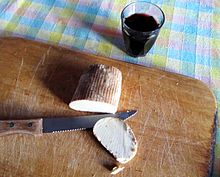
A piece of soft curd cheese, oven-baked to increase longevity
Cheese is an ancient food whose origins predate recorded history. There is no conclusive evidence indicating where cheesemaking originated, whether in Europe, Central Asia or the Middle East, but the practice had spread within Europe prior to Roman times and, according to Pliny the Elder, had become a sophisticated enterprise by the time the Roman Empire came into being.[6]
Earliest proposed dates for the origin of cheesemaking range from around 8000 BCE, when sheep were first domesticated. Since animal skins and inflated internal organs have, since ancient times, provided storage vessels for a range of foodstuffs, it is probable that the process of cheese making was discovered accidentally by storing milk in a container made from the stomach of an animal, resulting in the milk being turned to curd and whey by the rennet from the stomach.[7] There is a legend—with variations—about the discovery of cheese by an Arab trader who used this method of storing milk.[8]
The earliest evidence of cheesemaking in the archaeological record dates back to 5500 BCE and is found in what is now Kuyavia, Poland, where strainers coated with milk-fat molecules have been found.[9]
Cheesemaking may have begun independently of this by the pressing and salting of curdled milk to preserve it. Observation that the effect of making cheese in an animal stomach gave more solid and better-textured curds may have led to the deliberate addition of rennet. Early archeological evidence of Egyptian cheese has been found in Egyptian tomb murals, dating to about 2000 BCE.[10] A 2018 scientific paper stated that the world’s oldest cheese, dating to approximately 1200 BCE (3200 years before present), was found in ancient Egyptian tombs.[11][12]
The earliest cheeses were likely quite sour and salty, similar in texture to rustic cottage cheese or feta, a crumbly, flavorful Greek cheese. Cheese produced in Europe, where climates are cooler than the Middle East, required less salt for preservation. With less salt and acidity, the cheese became a suitable environment for useful microbes and molds, giving aged cheeses their respective flavors. The earliest ever discovered preserved cheese was found in the Taklamakan Desert in Xinjiang, China, dating back as early as 1615 BCE (3600 years before present).[13]
Ancient Greece and Rome
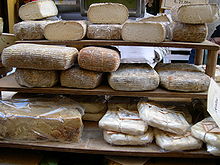
Cheese in a market in Italy
Ancient Greek mythology credited Aristaeus with the discovery of cheese. Homer‘s Odyssey (8th century BCE) describes the Cyclops making and storing sheep’s and goats’ milk cheese (translation by Samuel Butler):
We soon reached his cave, but he was out shepherding, so we went inside and took stock of all that we could see. His cheese-racks were loaded with cheeses, and he had more lambs and kids than his pens could hold…
When he had so done he sat down and milked his ewes and goats, all in due course, and then let each of them have her own young. He curdled half the milk and set it aside in wicker strainers.[14]
By Roman times, cheese was an everyday food and cheesemaking a mature art. Columella‘s De Re Rustica (c. 65 CE) details a cheesemaking process involving rennet coagulation, pressing of the curd, salting, and aging. Pliny’s Natural History (77 CE) devotes a chapter (XI, 97) to describing the diversity of cheeses enjoyed by Romans of the early Empire. He stated that the best cheeses came from the villages near Nîmes, but did not keep long and had to be eaten fresh. Cheeses of the Alps and Apennines were as remarkable for their variety then as now. A Ligurian cheese was noted for being made mostly from sheep’s milk, and some cheeses produced nearby were stated to weigh as much as a thousand pounds each. Goats’ milk cheese was a recent taste in Rome, improved over the “medicinal taste” of Gaul‘s similar cheeses by smoking. Of cheeses from overseas, Pliny preferred those of Bithynia in Asia Minor.
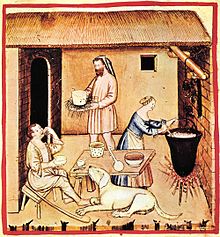
Cheese, Tacuinum sanitatis Casanatensis (14th century)
Post-Roman Europe
As Romanized populations encountered unfamiliar newly settled neighbors, bringing their own cheese-making traditions, their own flocks and their own unrelated words for cheese, cheeses in Europe diversified further, with various locales developing their own distinctive traditions and products. As long-distance trade collapsed, only travelers would encounter unfamiliar cheeses: Charlemagne‘s first encounter with a white cheese that had an edible rind forms one of the constructed anecdotes of Notker‘s Life of the Emperor.
The British Cheese Board claims that Britain has approximately 700 distinct local cheeses;[15] France and Italy have perhaps 400 each. (A French proverb holds there is a different French cheese for every day of the year, and Charles de Gaulle once asked “how can you govern a country in which there are 246 kinds of cheese?”)[16] Still, the advancement of the cheese art in Europe was slow during the centuries after Rome’s fall. Many cheeses today were first recorded in the late Middle Ages or after—cheeses like Cheddar around 1500, Parmesan in 1597, Gouda in 1697, and Camembert in 1791.[17]
In 1546, The Proverbs of John Heywood claimed “the moon is made of a greene cheese.” (Greene may refer here not to the color, as many now think, but to being new or unaged.)[18] Variations on this sentiment were long repeated and NASA exploited this myth for an April Fools’ Day spoof announcement in 2006.[19]
Modern era
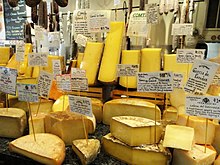
Cheese display in grocery store, Cambridge, Massachusetts, United States.
Until its modern spread along with European culture, cheese was nearly unheard of in east Asian cultures and in the pre-Columbian Americas and had only limited use in sub-Mediterranean Africa, mainly being widespread and popular only in Europe, the Middle East, the Indian subcontinent, and areas influenced by those cultures. But with the spread, first of European imperialism, and later of Euro-American culture and food, cheese has gradually become known and increasingly popular worldwide.
The first factory for the industrial production of cheese opened in Switzerland in 1815, but large-scale production first found real success in the United States. Credit usually goes to Jesse Williams, a dairy farmer from Rome, New York, who in 1851 started making cheese in an assembly-line fashion using the milk from neighboring farms. Within decades, hundreds of such dairy associations existed.[20]
The 1860s saw the beginnings of mass-produced rennet, and by the turn of the century scientists were producing pure microbial cultures. Before then, bacteria in cheesemaking had come from the environment or from recycling an earlier batch’s whey; the pure cultures meant a more standardized cheese could be produced.[21]
Factory-made cheese overtook traditional cheesemaking in the World War II era, and factories have been the source of most cheese in America and Europe ever since.
| Production of cheese – 2014 From whole cow milk |
|
|---|---|
| Place | Production (millions of tonnes) |
Production
In 2014, world production of cheese from whole cow milk was 18.7 million tonnes, with the United States accounting for 29% (5.4 million tonnes) of the world total followed by Germany, France and Italy as major producers (table).[22]
Other 2014 world totals for processed cheese include:[22]
- from skimmed cow milk, 2.4 million tonnes (leading country, Germany, 845,500 tonnes)
- from goat milk, 523,040 tonnes (leading country, South Sudan, 110,750 tonnes)
- from sheep milk, 680,302 tonnes (leading country, Greece, 125,000 tonnes)
- from buffalo milk, 282,127 tonnes (leading country, Egypt, 254,000 tonnes)
During 2015, Germany, France, Netherlands and Italy exported 10-14% of their produced cheese.[23] The United States was a marginal exporter (5.3% of total cow milk production), as most of its output was for the domestic market.[23]
Consumption
France, Iceland, Finland, Denmark and Germany were the highest consumers of cheese in 2014, averaging 25 kg (55 lb) per person.[24]
Processing
|
This article needs additional citations for verification. (February 2013) (Learn how and when to remove this template message)
|
Curdling

During industrial production of Emmental cheese, the as-yet-undrained curd is broken by rotating mixers.
A required step in cheesemaking is separating the milk into solid curds and liquid whey. Usually this is done by acidifying (souring) the milk and adding rennet. The acidification can be accomplished directly by the addition of an acid, such as vinegar, in a few cases (paneer, queso fresco). More commonly starter bacteria are employed instead which convert milk sugars into lactic acid. The same bacteria (and the enzymes they produce) also play a large role in the eventual flavor of aged cheeses. Most cheeses are made with starter bacteria from the Lactococcus, Lactobacillus, or Streptococcus families. Swiss starter cultures also include Propionibacter shermani, which produces carbon dioxide gas bubbles during aging, giving Swiss cheese or Emmental its holes (called “eyes“).
Some fresh cheeses are curdled only by acidity, but most cheeses also use rennet. Rennet sets the cheese into a strong and rubbery gel compared to the fragile curds produced by acidic coagulation alone. It also allows curdling at a lower acidity—important because flavor-making bacteria are inhibited in high-acidity environments. In general, softer, smaller, fresher cheeses are curdled with a greater proportion of acid to rennet than harder, larger, longer-aged varieties.
While rennet was traditionally produced via extraction from the inner mucosa of the fourth stomach chamber of slaughtered young, unweaned calves, most rennet used today in cheesemaking is produced recombinantly.[25] The majority of the applied chymosin is retained in the whey and, at most, may be present in cheese in trace quantities. In ripe cheese, the type and provenance of chymosin used in production cannot be determined.[25]
Curd processing
At this point, the cheese has set into a very moist gel. Some soft cheeses are now essentially complete: they are drained, salted, and packaged. For most of the rest, the curd is cut into small cubes. This allows water to drain from the individual pieces of curd.
Some hard cheeses are then heated to temperatures in the range of 35–55 °C (95–131 °F). This forces more whey from the cut curd. It also changes the taste of the finished cheese, affecting both the bacterial culture and the milk chemistry. Cheeses that are heated to the higher temperatures are usually made with thermophilic starter bacteria that survive this step—either Lactobacilli or Streptococci.
Salt has roles in cheese besides adding a salty flavor. It preserves cheese from spoiling, draws moisture from the curd, and firms cheese’s texture in an interaction with its proteins. Some cheeses are salted from the outside with dry salt or brine washes. Most cheeses have the salt mixed directly into the curds.
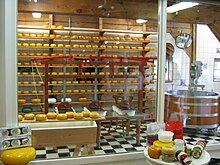
Cheese factory in the Netherlands
Other techniques influence a cheese’s texture and flavor. Some examples are :
- Stretching: (Mozzarella, Provolone) The curd is stretched and kneaded in hot water, developing a stringy, fibrous body.
- Cheddaring: (Cheddar, other English cheeses) The cut curd is repeatedly piled up, pushing more moisture away. The curd is also mixed (or milled) for a long time, taking the sharp edges off the cut curd pieces and influencing the final product’s texture.
- Washing: (Edam, Gouda, Colby) The curd is washed in warm water, lowering its acidity and making for a milder-tasting cheese.
Most cheeses achieve their final shape when the curds are pressed into a mold or form. The harder the cheese, the more pressure is applied. The pressure drives out moisture—the molds are designed to allow water to escape—and unifies the curds into a single solid body.

Parmigiano-Reggiano in a modern factory
Ripening
A newborn cheese is usually salty yet bland in flavor and, for harder varieties, rubbery in texture. These qualities are sometimes enjoyed—cheese curds are eaten on their own—but normally cheeses are left to rest under controlled conditions. This aging period (also called ripening, or, from the French, affinage) lasts from a few days to several years. As a cheese ages, microbes and enzymes transform texture and intensify flavor. This transformation is largely a result of the breakdown of casein proteins and milkfat into a complex mix of amino acids, amines, and fatty acids.
Some cheeses have additional bacteria or molds intentionally introduced before or during aging. In traditional cheesemaking, these microbes might be already present in the aging room; they are simply allowed to settle and grow on the stored cheeses. More often today, prepared cultures are used, giving more consistent results and putting fewer constraints on the environment where the cheese ages. These cheeses include soft ripened cheeses such as Brie and Camembert, blue cheeses such as Roquefort, Stilton, Gorgonzola, and rind-washed cheeses such as Limburger.
Types
There are many types of cheese, with around 500 different varieties recognized by the International Dairy Federation,[26] more than 400 identified by Walter and Hargrove, more than 500 by Burkhalter, and more than 1,000 by Sandine and Elliker.[27] The varieties may be grouped or classified into types according to criteria such as length of ageing, texture, methods of making, fat content, animal milk, country or region of origin, etc.—with these criteria either being used singly or in combination,[28] but with no single method being universally used.[29] The method most commonly and traditionally used is based on moisture content, which is then further discriminated by fat content and curing or ripening methods.[26][30] Some attempts have been made to rationalise the classification of cheese—a scheme was proposed by Pieter Walstra which uses the primary and secondary starter combined with moisture content, and Walter and Hargrove suggested classifying by production methods which produces 18 types, which are then further grouped by moisture content.[26]
-
Brie cheese
-
Maccagno cheese
-
Devil’s Gulch cheese
-
Isle of Mull Cheese
-
Diverse Sauermilchkäse sour cheese
Cooking and eating
At refrigerator temperatures, the fat in a piece of cheese is as hard as unsoftened butter, and its protein structure is stiff as well. Flavor and odor compounds are less easily liberated when cold. For improvements in flavor and texture, it is widely advised that cheeses be allowed to warm up to room temperature before eating. If the cheese is further warmed, to 26–32 °C (79–90 °F), the fats will begin to “sweat out” as they go beyond soft to fully liquid.[31]
Above room temperatures, most hard cheeses melt. Rennet-curdled cheeses have a gel-like protein matrix that is broken down by heat. When enough protein bonds are broken, the cheese itself turns from a solid to a viscous liquid. Soft, high-moisture cheeses will melt at around 55 °C (131 °F), while hard, low-moisture cheeses such as Parmesan remain solid until they reach about 82 °C (180 °F).[31] Acid-set cheeses, including halloumi, paneer, some whey cheeses and many varieties of fresh goat cheese, have a protein structure that remains intact at high temperatures. When cooked, these cheeses just get firmer as water evaporates.
Some cheeses, like raclette, melt smoothly; many tend to become stringy or suffer from a separation of their fats. Many of these can be coaxed into melting smoothly in the presence of acids or starch. Fondue, with wine providing the acidity, is a good example of a smoothly melted cheese dish.[31] Elastic stringiness is a quality that is sometimes enjoyed, in dishes including pizza and Welsh rarebit. Even a melted cheese eventually turns solid again, after enough moisture is cooked off. The saying “you can’t melt cheese twice” (meaning “some things can only be done once”) refers to the fact that oils leach out during the first melting and are gone, leaving the non-meltable solids behind.
As its temperature continues to rise, cheese will brown and eventually burn. Browned, partially burned cheese has a particular distinct flavor of its own and is frequently used in cooking (e.g., sprinkling atop items before baking them).
Cheeseboard
A cheeseboard (or cheese course) may be served at the end of a meal, either replacing, before or following dessert. The British tradition is to have cheese after dessert, accompanied by sweet wines like Port. In France, cheese is consumed before dessert, with robust red wine.[32][33] A cheeseboard typically has contrasting cheeses with accompaniments, such as crackers, biscuits, grapes, nuts, celery or chutney.[33] A cheeseboard 70 feet (21 m) long was used to feature the variety of cheeses manufactured in Wisconsin,[34] where the state legislature recognizes a “cheesehead” hat as a state symbol.[35]
Nutrition and health
The nutritional value of cheese varies widely. Cottage cheese may consist of 4% fat and 11% protein while some whey cheeses are 15% fat and 11% protein, and triple-crème cheeses are 36% fat and 7% protein.[36] In general, cheese is a rich source (20% or more of the Daily Value, DV) of calcium, protein, phosphorus, sodium and saturated fat. A 28-gram (one ounce) serving of cheddar cheese contains about 7 grams (0.25 oz) of protein and 202 milligrams of calcium.[36] Nutritionally, cheese is essentially concentrated milk, but altered by the culturing and aging processes: it takes about 200 grams (7.1 oz) of milk to provide that much protein, and 150 grams (5.3 oz) to equal the calcium.[36]
| Cheese | Water | Protein | Fat | Carbs |
|---|---|---|---|---|
| Swiss | 37.1 | 26.9 | 27.8 | 5.4 |
| Feta | 55.2 | 14.2 | 21.3 | 4.1 |
| Cheddar | 36.8 | 24.9 | 33.1 | 1.3 |
| Mozzarella | 50 | 22.2 | 22.4 | 2.2 |
| Cottage | 80 | 11.1 | 4.3 | 3.4 |
| Cheese | A | B1 | B2 | B3 | B5 | B6 | B9 | B12 | Ch. | C | D | E | K |
|---|---|---|---|---|---|---|---|---|---|---|---|---|---|
| Swiss | 17 | 4 | 17 | 0 | 4 | 4 | 1 | 56 | 2.8 | 0 | 11 | 2 | 3 |
| Feta | 8 | 10 | 50 | 5 | 10 | 21 | 8 | 28 | 2.2 | 0 | 0 | 1 | 2 |
| Cheddar | 20 | 2 | 22 | 0 | 4 | 4 | 5 | 14 | 3 | 0 | 3 | 1 | 3 |
| Mozzarella | 14 | 2 | 17 | 1 | 1 | 2 | 2 | 38 | 2.8 | 0 | 0 | 1 | 3 |
| Cottage | 3 | 2 | 10 | 0 | 6 | 2 | 3 | 7 | 3.3 | 0 | 0 | 0 | 0 |
| Cheese | Ca | Fe | Mg | P | K | Na | Zn | Cu | Mn | Se |
|---|---|---|---|---|---|---|---|---|---|---|
| Swiss | 79 | 10 | 1 | 57 | 2 | 8 | 29 | 2 | 0 | 26 |
| Feta | 49 | 4 | 5 | 34 | 2 | 46 | 19 | 2 | 1 | 21 |
| Cheddar | 72 | 4 | 7 | 51 | 3 | 26 | 21 | 2 | 1 | 20 |
| Mozzarella | 51 | 2 | 5 | 35 | 2 | 26 | 19 | 1 | 1 | 24 |
| Cottage | 8 | 0 | 2 | 16 | 3 | 15 | 3 | 1 | 0 | 14 |
[37] Ch. = Choline; Ca = Calcium; Fe = Iron; Mg = Magnesium; P = Phosphorus; K = Potassium; Na = Sodium; Zn = Zinc; Cu = Copper; Mn = Manganese; Se = Selenium;
Note : All nutrient values including protein are in %DV per 100 g of the food item except for Macronutrients. Source : Nutritiondata.self.com
Cardiovascular disease
National health organizations, such as the American Heart Association, Association of UK Dietitians, British National Health Service, and Mayo Clinic, among others, recommend that cheese consumption be minimized, replaced in snacks and meals by plant foods, or restricted to low-fat cheeses to reduce caloric intake and blood levels of HDL fat, which is a risk factor for cardiovascular diseases.[38][39][40][41] There is no high-quality clinical evidence that cheese consumption lowers the risk of cardiovascular diseases.[38]
Pasteurization
A number of food safety agencies around the world have warned of the risks of raw-milk cheeses. The U.S. Food and Drug Administration states that soft raw-milk cheeses can cause “serious infectious diseases including listeriosis, brucellosis, salmonellosis and tuberculosis“.[42] It is U.S. law since 1944 that all raw-milk cheeses (including imports since 1951) must be aged at least 60 days. Australia has a wide ban on raw-milk cheeses as well, though in recent years exceptions have been made for Swiss Gruyère, Emmental and Sbrinz, and for French Roquefort.[43] There is a trend for cheeses to be pasteurized even when not required by law.
Pregnant women may face an additional risk from cheese; the U.S. Centers for Disease Control has warned pregnant women against eating soft-ripened cheeses and blue-veined cheeses, due to the listeria risk, which can cause miscarriage or harm the fetus.[44]
Cultural attitudes

A traditional Polish sheep’s cheese market in Zakopane, Poland
Although cheese is a vital source of nutrition in many regions of the world and it is extensively consumed in others, its use is not universal.
Cheese is rarely found in Southeast and East Asian cuisines, presumably for historical reasons as dairy farming has historically been rare in these regions. However, Asian sentiment against cheese is not universal. Paneer (pronounced [pəniːr]) is a fresh cheese common in the Indian subcontinent. It is an unaged, non-melting soft cheese made by curdling milk with a fruit- or vegetable-derived acid, such as lemon juice. Its acid-set form, (cheese curd) before pressing, is called chhena. In Nepal, the Dairy Development Corporation commercially manufactures cheese made from yak milk and a hard cheese made from either cow or yak milk known as chhurpi.[45] The national dish of Bhutan, ema datshi, is made from homemade yak or mare milk cheese and hot peppers.[46] In Yunnan, China, several ethnic minority groups produce Rushan and Rubing from cow’s milk.[47] Cheese consumption may be increasing in China, with annual sales doubling from 1996 to 2003 (to a still small 30 million U.S. dollars a year).[48] Certain kinds of Chinese preserved bean curd are sometimes misleadingly referred to in English as “Chinese cheese” because of their texture and strong flavor.
Strict followers of the dietary laws of Islam and Judaism must avoid cheeses made with rennet from animals not slaughtered in a manner adhering to halal or kosher laws.[49] Both faiths allow cheese made with vegetable-based rennet or with rennet made from animals that were processed in a halal or kosher manner. Many less orthodox Jews also believe that rennet undergoes enough processing to change its nature entirely and do not consider it to ever violate kosher law. (See Cheese and kashrut.) As cheese is a dairy food, under kosher rules it cannot be eaten in the same meal with any meat.
Rennet derived from animal slaughter, and thus cheese made with animal-derived rennet, is not vegetarian. Most widely available vegetarian cheeses are made using rennet produced by fermentation of the fungus Mucor miehei.[50] Vegans and other dairy-avoiding vegetarians do not eat conventional cheese, but some vegetable-based cheese substitutes (soy or almond) are used as substitutes.[50]
Even in cultures with long cheese traditions, consumers may perceive some cheeses that are especially pungent-smelling, or mold-bearing varieties such as Limburger or Roquefort, as unpalatable. Such cheeses are an acquired taste because they are processed using molds or microbiological cultures,[51] allowing odor and flavor molecules to resemble those in rotten foods. One author stated: “An aversion to the odor of decay has the obvious biological value of steering us away from possible food poisoning, so it is no wonder that an animal food that gives off whiffs of shoes and soil and the stable takes some getting used to.”[31]
Collecting cheese labels is called “tyrosemiophilia“.[52]
Figurative expressions
In the 19th century, “cheese” was used as a figurative way of saying “the proper thing”; this usage comes “from Urdu cheez “a thing,” from Persian cheez, from Old Persian…ciš-ciy [which means] “something.” The term “cheese” in this sense was “[p]icked up by [colonial] British in India by 1818 and [was also] used in the sense of “a big thing”, for example in the expression “he’s the real cheez”.[5] The expression “big cheese” was attested in use in 1914 to mean an “important person”; this is likely “American English in origin”. The expression “to cut a big cheese” was used to mean “to look important”; this figurative expression referred to the huge wheels of cheese displayed by cheese retailers as a publicity stunt.[5] The phrase “cut the cheese” also became an American slang term meaning to flatulate. The word “cheese” has also had the meaning of “an ignorant, stupid person.”[5]
Other figurative meanings involve the word “cheese” used as a verb. To “cheese” is recorded as meaning to “stop (what one is doing), run off,” in 1812 (this was “thieves’ slang”).[5] To be “cheesed off” means to be annoyed.[5] The expression “say cheese” in a photograph-taking context (when the photographer wishes the people to smile for the photo), which means “to smile” dates from 1930 (the word was probably chosen because the “ee” encourages people to make a smile).[5] The verb “cheese” was used as slang for “be quiet” in the early 19th century in Britain.[5] The fictional “…notion that the moon is made of green cheese as a type of a ridiculous assertion is from 1520s”.[5] The figurative expression “to make cheeses” is an 1830s phrase referring to schoolgirls who amuse themselves by “…wheeling rapidly so one’s petticoats blew out in a circle then dropping down so they came to rest inflated and resembling a wheel of cheese”.[5] In video game slang “to cheese it” means to win a game by using a strategy that requires minimal skill and knowledge or that exploits a glitch or flaw in game design.[53]
The adjective “cheesy” has two meanings. The first is literal, and means “cheese-like”; this definition is attested to from the late 14th century (e.g., “a cheesy substance oozed from the broken jar”).[5] In the late 19th century, medical writers used the term “cheesy” in a more literal sense, “to describe morbid substances found in tumors, decaying flesh, etc.”[5] The adjective also has a figurative sense, meaning “cheap, inferior”; this use “… is attested from 1896, perhaps originally U.S. student slang”. In the late 19th century in British slang, “cheesy” meant “fine, showy”; this use is attested to in the 1850s. In writing lyrics for pop music, rock music or musical theatre, “cheesy” is a pejorative term which means “blatantly artificial” (OED).







